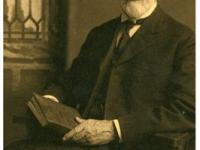Addison Hutton
The Historical Society of Pennsylvania was founded in 1824, and for its first 60 years or so, it moved from place to place in search of a permanent home. It rented rooms in Carpenters’ Hall, the American Philosophical Society, and the Athenaeum, among other sites. Finally in 1883, the Society purchased a mansion at 13th and Locust Streets for $50,000, the former home of General Robert Patterson, who had served in the Mexican American and Civil Wars. The Society made changes to the building to accommodate its collection and added fireproof storage space. But the fireproof storage area was not large enough to store the Society’s entire collection, and members worried that a fire could destroy or damage its irreplaceable documents. So the Society embarked on an ambitious building project and employed architect Addison Hutton.
During construction, the Society took pains to make sure the building was as fireproof as possible. Its thick walls were made of brick. No wood was used in the construction, not even for the bookcases or furniture. Each room was divided by a fireproof door hung on an inclined railway track, counter-weighted so that when the temperature rises a fusible plug melts and the door automatically closes. On April 24, 1905, John Frederick Lewis, chairman of the Society’s Building Committee, reported that “the inspector, after having examined the building from the roofing to the cellar, said that it was the most perfect fire-proof building of which he had any knowledge in this portion of the country.” In April 1910, construction was complete and the building opened to the public.

